Radioactivity | Chemistry for ACT PDF Download
| Table of contents |

|
| Introduction |

|
| Nuclear Equations |

|
| Induced Nuclear Reactions |

|
| Synthesis of Transuranium Elements |

|
| Summary and Key Takeaway |

|
Introduction
Nuclear chemistry involves the examination of reactions that bring about alterations in the structure of atomic nuclei. In the previous section on atoms, molecules, and ions, the fundamental concept of nuclear structure was introduced, which states that the nucleus of an atom is comprised of protons and, except for hydrogen-1, neutrons. It is important to remember that the number of protons present in the nucleus is referred to as the atomic number (Z) of the element, while the combined number of protons and neutrons is known as the mass number (A). Isotopes of the same element have identical atomic numbers but different mass numbers. When discussing a specific type of nucleus, we often use the term nuclide and represent it using the following notation:

where
- X is the symbol for the element,
- A is the mass number, and
- Z is the atomic number.
Often a nuclide is referenced by the name of the element followed by a hyphen and the mass number. For example,  is called “carbon-14.”
is called “carbon-14.”
The nucleus, consisting of protons and neutrons known collectively as nucleons, is densely packed together. It has a radius of approximately 10-15 meters, making it significantly smaller compared to the overall radius of an atom, which is about 10-10 meters. Nuclei exhibit an extremely high density when compared to bulk matter, with an average of 1.8 x 1014 grams per cubic centimeter. To provide context, the density of water is 1 gram per cubic centimeter, while iridium, one of the densest elements, has a density of 22.6 g/cm3. If the Earth had the same density as an average nucleus, its radius would be only around 200 meters (in reality, the Earth's radius is approximately 6.4 x 106 meters, which is 30,000 times larger).
Changes of nuclei that result in changes in their atomic numbers, mass numbers, or energy states are nuclear reactions. To describe a nuclear reaction, we use an equation that identifies the nuclides involved in the reaction, their mass numbers and atomic numbers, and the other particles involved in the reaction.
Nuclear Equations
A chemical reaction equation that is balanced signifies that bonds are broken and formed, and atoms undergo rearrangement, while the total number of atoms for each element remains unchanged and conserved. On the other hand, a balanced nuclear reaction equation indicates a rearrangement of subatomic particles rather than whole atoms during a nuclear reaction. Nuclear reactions also adhere to conservation laws and are balanced in two aspects:
- The sum of the mass numbers of the reactants equals the sum of the mass numbers of the products.
- The sum of the charges of the reactants equals the sum of the charges of the products.
If the atomic number and the mass number of all but one of the particles in a nuclear reaction are known, we can identify the particle by balancing the reaction. For instance, we could determine that  is a product of the nuclear reaction of
is a product of the nuclear reaction of  if we knew that a proton,
if we knew that a proton,  was one of the two products. Example shows how we can identify a nuclide by balancing the nuclear reaction.
was one of the two products. Example shows how we can identify a nuclide by balancing the nuclear reaction.
Example 1: Balancing Equations for Nuclear Reactions
The reaction of an α particle with magnesium-25  produces a proton and a nuclide of another element. Identify the new nuclide produced.
produces a proton and a nuclide of another element. Identify the new nuclide produced.
The nuclear reaction can be written as:
where
A is the mass number and
Z is the atomic number of the new nuclide, X.
Because the sum of the mass numbers of the reactants must equal the sum of the mass numbers of the products:
25 + 4 = A + 1
so
A = 28
Similarly, the charges must balance, so:
12 + 2 = Z + 1
so
Z = 13
Check the periodic table: The element with nuclear charge = +13 is aluminum. Thus, the product is
Example 2: Balancing Equations for Nuclear Reactions
The nuclide  combines with an electron and produces a new nucleus and no other massive particles. What is the equation for this reaction?
combines with an electron and produces a new nucleus and no other massive particles. What is the equation for this reaction?
There are two main types of nuclear reactions: nuclear decay reactions and nuclear transmutation reactions. In a nuclear decay reaction, also known as radioactive decay, an unstable nucleus emits radiation and transforms into one or more nuclei of different elements. The resulting daughter nuclei have lower mass and energy (greater stability) compared to the original decaying parent nucleus. On the other hand, in a nuclear transmutation reaction, a nucleus interacts with a subatomic particle or another nucleus, resulting in the formation of a product nucleus that is more massive than the initial material. It is important to note that nuclear decay reactions occur spontaneously in all conditions, while nuclear transmutation reactions only occur under specific circumstances, such as the collision of highly energetic particles with a target nucleus or within the core of stars. To begin this section, we will explore the various classes of radioactive nuclei, their characteristic nuclear decay reactions, and the radiation they emit.
Nuclear decay reactions occur spontaneously under all conditions, whereas nuclear transmutation reactions are induced.
Nuclear Decay Reactions
Similar to how we balance a chemical equation by considering the number and type of atoms involved, we can balance a nuclear equation for a nuclear decay reaction by considering the number and type of nucleons present. This approach also enables us to predict the identity of either the parent or the daughter nucleus if we only know the identity of one of them. Regardless of the specific decay mode, the total number of nucleons remains conserved in all nuclear reactions.
To describe nuclear decay reactions, chemists have extended the  notation for nuclides to include radioactive emissions. Table 1. lists the name and symbol for each type of emitted radiation. The most notable addition is the positron, a particle that has the same mass as an electron but a positive charge rather than a negative charge.
notation for nuclides to include radioactive emissions. Table 1. lists the name and symbol for each type of emitted radiation. The most notable addition is the positron, a particle that has the same mass as an electron but a positive charge rather than a negative charge.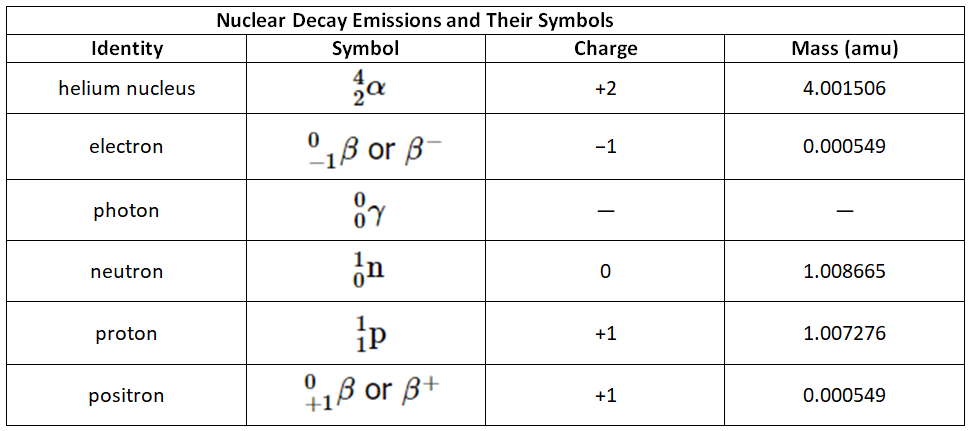
Similar to how isotopes are indicated by notation, the superscript in the upper left of a particle's symbol represents the mass number, which corresponds to the total count of protons and neutrons. For protons or neutrons, the mass number (A) is 1. However, in the case of an electron or a positron, which do not possess protons or neutrons, their mass number is 0. It's important to note that these numbers should not be interpreted literally as indicating zero mass for these particles. The emission of a beta particle (an electron) during a nuclear decay reaction has a negligible effect on the mass of a nucleus.
Similarly, the lower left subscript gives the charge of the particle. Because protons carry a positive charge, Z = +1 for a proton. In contrast, a neutron contains no protons and is electrically neutral, so Z = 0. In the case of an electron, Z = −1, and for a positron, Z = +1. Because γ rays are high-energy photons, both A and Z are 0. In some cases, two different symbols are used for particles that are identical but produced in different ways. For example, the symbol  which is usually simplified to e−, represents a free electron or an electron associated with an atom, whereas the symbol
which is usually simplified to e−, represents a free electron or an electron associated with an atom, whereas the symbol  which is often simplified to β−, denotes an electron that originates from within the nucleus, which is a β particle. Similarly,
which is often simplified to β−, denotes an electron that originates from within the nucleus, which is a β particle. Similarly,  refers to the nucleus of a helium atom, and 42α denotes an identical particle that has been ejected from a heavier nucleus. There are six fundamentally different kinds of nuclear decay reactions, and each releases a different kind of particle or energy. The essential features of each reaction are shown in Figure 1. The most common are alpha and beta decay and gamma emission, but the others are essential to an understanding of nuclear decay reactions.
refers to the nucleus of a helium atom, and 42α denotes an identical particle that has been ejected from a heavier nucleus. There are six fundamentally different kinds of nuclear decay reactions, and each releases a different kind of particle or energy. The essential features of each reaction are shown in Figure 1. The most common are alpha and beta decay and gamma emission, but the others are essential to an understanding of nuclear decay reactions.
Common Modes of Nuclear Decay 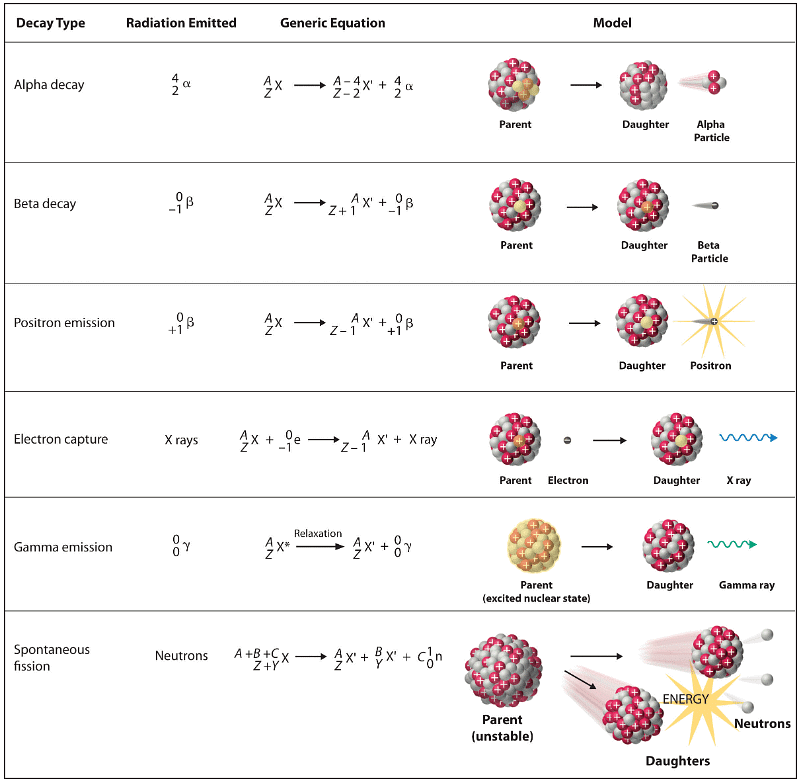
The different types of decay are alpha, beta, positron emission, electron capture, gamma emission, and spontaneous fission.
Alpha α Decay
Many nuclei with mass numbers greater than 200 undergo alpha (α) decay, which results in the emission of a helium-4 nucleus as an alpha (α) particle,  The general reaction is as follows:
The general reaction is as follows: The daughter nuclide contains two fewer protons and two fewer neutrons than the parent. Thus α- particle emission produces a daughter nucleus with a mass number A − 4 and a nuclear charge Z − 2 compared to the parent nucleus. Radium-226, for example, undergoes alpha decay to form radon-222:
The daughter nuclide contains two fewer protons and two fewer neutrons than the parent. Thus α- particle emission produces a daughter nucleus with a mass number A − 4 and a nuclear charge Z − 2 compared to the parent nucleus. Radium-226, for example, undergoes alpha decay to form radon-222:
Because nucleons are conserved in this and all other nuclear reactions, the sum of the mass numbers of the products, 222 + 4 = 226, equals the mass number of the parent. Similarly, the sum of the atomic numbers of the products, 86 + 2 = 88, equals the atomic number of the parent. Thus the nuclear equation is balanced.
Just as the total number of atoms is conserved in a chemical reaction, the total number of nucleons is conserved in a nuclear reaction.
Beta β− Decay
Nuclei that contain too many neutrons often undergo beta (β) decay, in which a neutron is converted to a proton and a high-energy electron that is ejected from the nucleus as a β particle: The general reaction for beta decay is therefore
The general reaction for beta decay is therefore Although beta decay does not change the mass number of the nucleus, it does result in an increase of +1 in the atomic number because of the addition of a proton in the daughter nucleus. Thus beta decay decreases the neutron-to-proton ratio, moving the nucleus toward the band of stable nuclei. For example, carbon-14 undergoes beta decay to form nitrogen-14:
Although beta decay does not change the mass number of the nucleus, it does result in an increase of +1 in the atomic number because of the addition of a proton in the daughter nucleus. Thus beta decay decreases the neutron-to-proton ratio, moving the nucleus toward the band of stable nuclei. For example, carbon-14 undergoes beta decay to form nitrogen-14: Once again, the number of nucleons is conserved, and the charges are balanced. The parent and the daughter nuclei have the same mass number, 14, and the sum of the atomic numbers of the products is 6, which is the same as the atomic number of the carbon-14 parent.
Once again, the number of nucleons is conserved, and the charges are balanced. The parent and the daughter nuclei have the same mass number, 14, and the sum of the atomic numbers of the products is 6, which is the same as the atomic number of the carbon-14 parent.
Positron β+ Emission
Because a positron has the same mass as an electron but opposite charge, positron emission is the opposite of beta decay. Thus positron emission is characteristic of neutron-poor nuclei, which decay by transforming a proton to a neutron and emitting a high-energy positron: The general reaction for positron emission is therefore
The general reaction for positron emission is therefore Like beta decay, positron emission does not change the mass number of the nucleus. In this case, however, the atomic number of the daughter nucleus is lower by 1 than that of the parent. Thus the neutron-to-proton ratio has increased, again moving the nucleus closer to the band of stable nuclei. For example, carbon-11 undergoes positron emission to form boron-11:
Like beta decay, positron emission does not change the mass number of the nucleus. In this case, however, the atomic number of the daughter nucleus is lower by 1 than that of the parent. Thus the neutron-to-proton ratio has increased, again moving the nucleus closer to the band of stable nuclei. For example, carbon-11 undergoes positron emission to form boron-11: Nucleons are conserved, and the charges balance. The mass number, 11, does not change, and the sum of the atomic numbers of the products is 6, the same as the atomic number of the parent carbon-11 nuclide.
Nucleons are conserved, and the charges balance. The mass number, 11, does not change, and the sum of the atomic numbers of the products is 6, the same as the atomic number of the parent carbon-11 nuclide.
Electron Capture
A neutron-poor nucleus can decay by either positron emission or electron capture (EC), in which an electron in an inner shell reacts with a proton to produce a neutron: When a second electron moves from an outer shell to take the place of the lower-energy electron that was absorbed by the nucleus, an x-ray is emitted. The overall reaction for electron capture is thus
When a second electron moves from an outer shell to take the place of the lower-energy electron that was absorbed by the nucleus, an x-ray is emitted. The overall reaction for electron capture is thus Electron capture does not change the mass number of the nucleus because both the proton that is lost and the neutron that is formed have a mass number of 1. As with positron emission, however, the atomic number of the daughter nucleus is lower by 1 than that of the parent. Once again, the neutron-to-proton ratio has increased, moving the nucleus toward the band of stable nuclei. For example, iron-55 decays by electron capture to form manganese-55, which is often written as follows:
Electron capture does not change the mass number of the nucleus because both the proton that is lost and the neutron that is formed have a mass number of 1. As with positron emission, however, the atomic number of the daughter nucleus is lower by 1 than that of the parent. Once again, the neutron-to-proton ratio has increased, moving the nucleus toward the band of stable nuclei. For example, iron-55 decays by electron capture to form manganese-55, which is often written as follows: The atomic numbers of the parent and daughter nuclides differ in Equation 20.2.11, although the mass numbers are the same. To write a balanced nuclear equation for this reaction, we must explicitly include the captured electron in the equation:
The atomic numbers of the parent and daughter nuclides differ in Equation 20.2.11, although the mass numbers are the same. To write a balanced nuclear equation for this reaction, we must explicitly include the captured electron in the equation: Both positron emission and electron capture are usually observed for nuclides with low neutron-to-proton ratios, but the decay rates for the two processes can be very different.
Both positron emission and electron capture are usually observed for nuclides with low neutron-to-proton ratios, but the decay rates for the two processes can be very different.
Gamma γ Emission
Many nuclear decay reactions produce daughter nuclei that are in a nuclear excited state, which is similar to an atom in which an electron has been excited to a higher-energy orbital to give an electronic excited state. Just as an electron in an electronic excited state emits energy in the form of a photon when it returns to the ground state, a nucleus in an excited state releases energy in the form of a photon when it returns to the ground state. These high-energy photons are γ rays. Gamma (γ) emission can occur virtually instantaneously, as it does in the alpha decay of uranium-238 to thorium-234, where the asterisk denotes an excited state: If we disregard the decay event that created the excited nucleus, then
If we disregard the decay event that created the excited nucleus, then or more generally,
or more generally,
Gamma emission can also occur after a significant delay. For example, technetium-99m has a half-life of about 6 hours before emitting a γ ray to form technetium-99 (the m is for metastable). Because γ rays are energy, their emission does not affect either the mass number or the atomic number of the daughter nuclide. Gamma-ray emission is therefore the only kind of radiation that does not necessarily involve the conversion of one element to another, although it is almost always observed in conjunction with some other nuclear decay reaction.
Spontaneous Fission
Only very massive nuclei with high neutron-to-proton ratios can undergo spontaneous fission, in which the nucleus breaks into two pieces that have different atomic numbers and atomic masses. This process is most important for the transactinide elements, with Z ≥ 104. Spontaneous fission is invariably accompanied by the release of large amounts of energy, and it is usually accompanied by the emission of several neutrons as well. An example is the spontaneous fission of  which gives a distribution of fission products; one possible set of products is shown in the following equation:
which gives a distribution of fission products; one possible set of products is shown in the following equation:
Once again, the number of nucleons is conserved. Thus the sum of the mass numbers of the products (118 + 132 + 4 = 254) equals the mass number of the reactant. Similarly, the sum of the atomic numbers of the products [46 + 52 + (4 × 0) = 98] is the same as the atomic number of the parent nuclide.
Example 3: Write a balanced nuclear equation to describe each reaction.
(a) the beta decay of 
(b) the decay of  by electron capture
by electron capture
(c) the decay of  by positron emission
by positron emission
Given: radioactive nuclide and mode of decay
Asked for: balanced nuclear equation
Strategy:
A. Identify the reactants and the products from the information given.
B. Use the values of A and Z to identify any missing components needed to balance the equation.
(a) A. We know the identities of the reactant and one of the products (a β particle). We can therefore begin by writing an equation that shows the reactant and one of the products and indicates the unknown product as
B. Because both protons and neutrons must be conserved in a nuclear reaction, the unknown product must have a mass number of A = 35 − 0 = 35 and an atomic number of Z = 16 − (−1) = 17. The element with Z = 17 is chlorine, so the balanced nuclear equation is as follows:
(b) A. We know the identities of both reactants:
and an inner electron,
The reaction is as follows:
B. Both protons and neutrons are conserved, so the mass number of the product must be A = 201 + 0 = 201, and the atomic number of the product must be Z = 80 + (−1) = 79, which corresponds to the element gold. The balanced nuclear equation is thus
(c) A. As in part (a), we are given the identities of the reactant and one of the products—in this case, a positron. The unbalanced nuclear equation is therefore
B. The mass number of the second product is A = 30 − 0 = 30, and its atomic number is Z = 15 − 1 = 14, which corresponds to silicon. The balanced nuclear equation for the reaction is as follows:
Example 4: Write a balanced nuclear equation to describe each reaction.
(a)  by positron emission
by positron emission
(b) the beta decay of molybdenum-99
(c) the emission of an α particle followed by gamma emission from 
(a)
(b)
(c)
Example 5: Predict the kind of nuclear change each unstable nuclide undergoes when it decays.
(a)
(b) 
(c) 
(d) 
Given: nuclide
Asked for: type of nuclear decay
Strategy: Based on the neutron-to-proton ratio and the value of Z, predict the type of nuclear decay reaction that will produce a more stable nuclide.
(a) This nuclide has a neutron-to-proton ratio of only 1.05, which is much less than the requirement for stability for an element with an atomic number in this range. Nuclei that have low neutron-to-proton ratios decay by converting a proton to a neutron. The two possibilities are positron emission, which converts a proton to a neutron and a positron, and electron capture, which converts a proton and a core electron to a neutron. In this case, both are observed, with positron emission occurring about 86% of the time and electron capture about 14% of the time.
(b) Nuclei with Z > 83 are too heavy to be stable and usually undergo alpha decay, which decreases both the mass number and the atomic number. Thusis expected to decay by alpha emission.
(c) This nuclide has a neutron-to-proton ratio of 1.4, which is very high for a light element. Nuclei with high neutron-to-proton ratios decay by converting a neutron to a proton and an electron. The electron is emitted as a β particle, and the proton remains in the nucleus, causing an increase in the atomic number with no change in the mass number. We therefore predict thatwill undergo beta decay.
(d) This is a massive nuclide, with an atomic number of 100 and a mass number much greater than 200. Nuclides with A ≥ 200 tend to decay by alpha emission, and even heavier nuclei tend to undergo spontaneous fission. We therefore predict thatwill decay by either or both of these two processes. In fact, it decays by both spontaneous fission and alpha emission, in a 97:3 ratio.
Example 6: Predict the kind of nuclear change each unstable nuclide undergoes when it decays.
(a) 
(b) 
(c) 
(a) beta decay
(b) positron emission or electron capture
(c) alpha decay
Radioactive Decay Series
The nuclei of elements with atomic numbers greater than 83 are inherently unstable. As a result, all isotopes of elements beyond bismuth in the periodic table are radioactive. Due to the nature of alpha decay, where Z (atomic number) decreases by only 2, and positron emission or electron capture, where Z decreases by only 1, it is not possible for a nuclide with Z > 85 to decay directly to a stable daughter nuclide in a single step, except through nuclear fission. Consequently, radioactive isotopes with Z > 85 typically undergo decay to a radioactive daughter nucleus, which in turn decays to another radioactive daughter nucleus, and so on, until a stable nucleus is eventually produced. This sequential series of alpha and beta decay reactions is referred to as a radioactive decay series. The most common is the uranium-238 decay series, which produces lead-206 in a series of 14 sequential alpha- and beta-decay reactions (Figure 2.). Although a radioactive decay series can be written for almost any isotope with Z > 85, only two others occur naturally: the decay of uranium-235 to lead-207 (in 11 steps) and thorium-232 to lead-208 (in 10 steps). A fourth series, the decay of neptunium-237 to bismuth-209 in 11 steps, is known to have occurred on the primitive Earth. With a half-life of “only” 2.14 million years, all the neptunium-237 present when Earth was formed decayed long ago, and today all the neptunium on Earth is synthetic.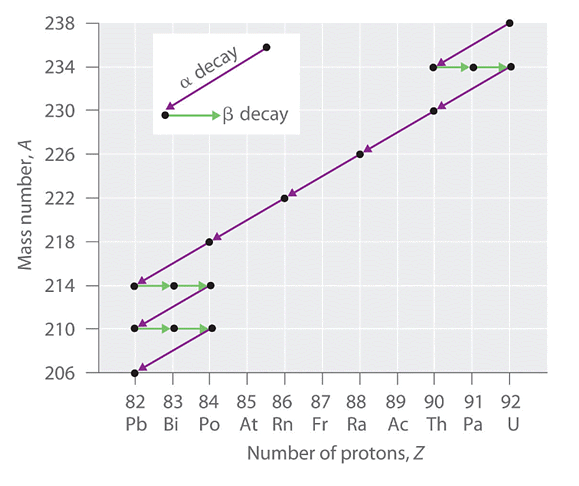 Figure 2: A Radioactive Decay Series: Three naturally occurring radioactive decay series are known to occur currently: the uranium-238 decay series, the decay of uranium-235 to lead-207, and the decay of thorium-232 to lead-208.
Figure 2: A Radioactive Decay Series: Three naturally occurring radioactive decay series are known to occur currently: the uranium-238 decay series, the decay of uranium-235 to lead-207, and the decay of thorium-232 to lead-208.
Graph of mass number against number of protons. The purple lines are alpha decay which are linear while the green lines are beta decay and are horizontal and parallel to the x axis.
As a result of radioactive decay series, trace amounts of highly unstable isotopes are present in ores containing uranium or thorium. These isotopes, which should have decayed into stable nuclei with lower atomic numbers over time, would not exist on Earth anymore. Nevertheless, due to the continuous generation resulting from the decay of uranium or thorium, their quantities have reached a state of equilibrium where the rate of their formation matches their rate of decay. In certain instances, the abundance of these daughter isotopes can be utilized to determine the age of a material or trace its origin.
Induced Nuclear Reactions
In the late 19th century, the detection of radioactivity revealed that certain atomic nuclei undergo spontaneous changes, resulting in the formation of nuclei with a different proton count, thereby creating a distinct element. Upon recognizing that these radioactive isotopes decay through the emission of subatomic particles, scientists understood that it could theoretically be feasible to reverse this process. This would involve bombarding a stable nucleus with subatomic particles in a nuclear transmutation reaction to convert it into a more massive nucleus.
The first successful nuclear transmutation reaction was carried out in 1919 by Ernest Rutherford, who showed that α particles emitted by radium could react with nitrogen nuclei to form oxygen nuclei. As shown in the following equation, a proton is emitted in the process:
Rutherford's experiments on nuclear transmutation played a significant role in the discovery of the neutron. Through his investigations, he observed that bombarding the nucleus of a lighter target element with an α particle generally resulted in the conversion of the target nucleus into a product with an atomic number one unit higher and a mass number three units higher than the original nucleus. This behavior indicated the probable emission of a proton following the interaction with the α particle. However, when dealing with extremely light targets like Li, Be, and B, a different response was observed—they emitted a new type of highly penetrating radiation rather than a proton. Rutherford deduced that these high-energy particles were electrically neutral since they were unaffected by magnetic or electric fields. Further observations indicated that the mass of these neutral particles was similar to that of a proton.
In 1932, James Chadwick, who was a student of Rutherford's at that time and later received the Nobel Prize in Physics in 1935, coined the term "neutrons" for these neutral particles and proposed that they were fundamental components of an atom. Chadwick initially used the following reaction to explain the production of neutrons:
Because α particles and atomic nuclei are both positively charged, electrostatic forces cause them to repel each other. Only α particles with very high kinetic energy can overcome this repulsion and collide with a nucleus (Figure 3). Neutrons have no electrical charge, however, so they are not repelled by the nucleus. Hence bombardment with neutrons is a much easier way to prepare new isotopes of the lighter elements. In fact, carbon-14 is formed naturally in the atmosphere by bombarding nitrogen-14 with neutrons generated by cosmic rays:
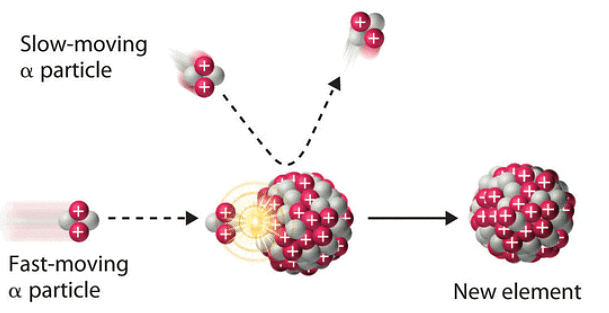 Figure 3: A Nuclear Transmutation Reaction: Bombarding a target of one element with high-energy nuclei or subatomic particles can create new elements. Electrostatic repulsions normally prevent a positively charged particle from colliding and reacting with a positively charged nucleus. If the positively charged particle is moving at a very high speed, however, its kinetic energy may be great enough to overcome the electrostatic repulsions, and it may collide with the target nucleus. Such collisions can result in a nuclear transmutation reaction.
Figure 3: A Nuclear Transmutation Reaction: Bombarding a target of one element with high-energy nuclei or subatomic particles can create new elements. Electrostatic repulsions normally prevent a positively charged particle from colliding and reacting with a positively charged nucleus. If the positively charged particle is moving at a very high speed, however, its kinetic energy may be great enough to overcome the electrostatic repulsions, and it may collide with the target nucleus. Such collisions can result in a nuclear transmutation reaction.
Example 7: In 1933, Frédéric Joliot and Iréne Joliot-Curie (daughter of Marie and Pierre Curie) prepared the first artificial radioactive isotope by bombarding aluminum-27 with α particles. For each 27Al that reacted, one neutron was released. Identify the product nuclide and write a balanced nuclear equation for this transmutation reaction.
Given: reactants in a nuclear transmutation reaction
Asked for: product nuclide and balanced nuclear equation
Strategy:
A. Based on the reactants and one product, identify the other product of the reaction. Use conservation of mass and charge to determine the values of Z and A of the product nuclide and thus its identity.
B. Write the balanced nuclear equation for the reaction.
A. Bombarding an element with α particles usually produces an element with an atomic number that is 2 greater than the atomic number of the target nucleus. Thus we expect that aluminum (Z = 13) will be converted to phosphorus (Z = 15). With one neutron released, conservation of mass requires that the mass number of the other product be 3 greater than the mass number of the target. In this case, the mass number of the target is 27, so the mass number of the product will be 30. The second product is therefore phosphorus-30,
B. The balanced nuclear equation for the reaction is as follows:
Example 8: Because all isotopes of technetium are radioactive and have short half-lives, it does not exist in nature. Technetium can, however, be prepared by nuclear transmutation reactions. For example, bombarding a molybdenum-96 target with deuterium nuclei  produces technetium-97. Identify the other product of the reaction and write a balanced nuclear equation for this transmutation reaction.
produces technetium-97. Identify the other product of the reaction and write a balanced nuclear equation for this transmutation reaction.
We noted earlier in this section that very heavy nuclides, corresponding to Z ≥ 104, tend to decay by spontaneous fission. Nuclides with slightly lower values of Z, such as the isotopes of uranium (Z = 92) and plutonium (Z = 94), do not undergo spontaneous fission at any significant rate. Some isotopes of these elements, however, such as undergo induced nuclear fission when they are bombarded with relatively low-energy neutrons, as shown in the following equation for uranium-235 and in Figure 4:
undergo induced nuclear fission when they are bombarded with relatively low-energy neutrons, as shown in the following equation for uranium-235 and in Figure 4:
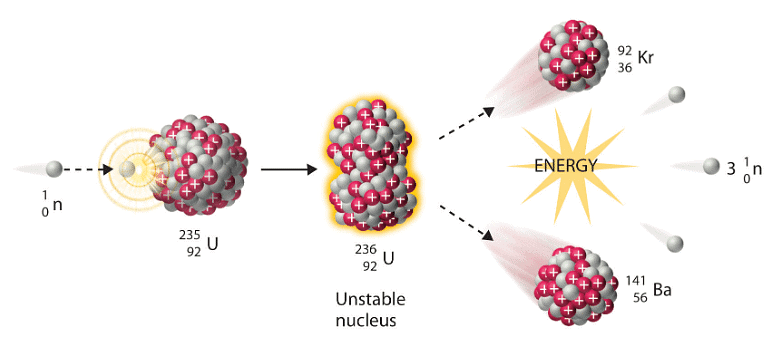
Figure 4: Neutron-Induced Nuclear Fission: Collision of a relatively slow-moving neutron with a fissile nucleus can split it into two smaller nuclei with the same or different masses. Neutrons are also released in the process, along with a great deal of energy.
Any isotope that can undergo a nuclear fission reaction when bombarded with neutrons is called a fissile isotope.
In the process of nuclear fission, the splitting of the nucleus typically occurs in an asymmetric manner rather than dividing into two equal parts, as depicted in Figure 4. Furthermore, each fission event of a particular nuclide does not yield the same products. For instance, uranium-235 has been found to exhibit over 50 different fission modes. As a result, describing the nuclear fission of a fissile nuclide cannot be accomplished through a single equation. Instead, as illustrated in Figure 5, a distribution of numerous pairs of fission products with varying yields is obtained. However, the mass ratio between each pair of fission products generated by a single fission event is consistently approximately 3 : 2.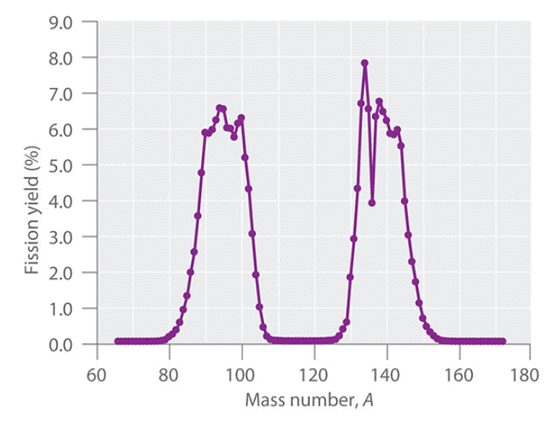 Figure 5: Mass Distribution of Nuclear Fission Products of 235U: Nuclear fission usually produces a range of products with different masses and yields, although the mass ratio of each pair of fission products from a fission event is approximately 3 : 2. As shown in this plot, more than 50 different fission products are known for 235U. Data source: T. R. England and B. F. Rider, Los Alamos National Laboratory, LA-UR-94-3106, ENDF-349 (1993).
Figure 5: Mass Distribution of Nuclear Fission Products of 235U: Nuclear fission usually produces a range of products with different masses and yields, although the mass ratio of each pair of fission products from a fission event is approximately 3 : 2. As shown in this plot, more than 50 different fission products are known for 235U. Data source: T. R. England and B. F. Rider, Los Alamos National Laboratory, LA-UR-94-3106, ENDF-349 (1993).
Synthesis of Transuranium Elements
Uranium (Z = 92) is the heaviest naturally occurring element. Consequently, all the elements with Z > 92, the transuranium elements, are artificial and have been prepared by bombarding suitable target nuclei with smaller particles. The first of the transuranium elements to be prepared was neptunium (Z = 93), which was synthesized in 1940 by bombarding a 238U target with neutrons. As shown in Equation below, this reaction occurs in two steps. Initially, a neutron combines with a 238U nucleus to form 239U, which is unstable and undergoes beta decay to produce 239Np: Subsequent beta decay of 239Np produces the second transuranium element, plutonium (Z = 94):
Subsequent beta decay of 239Np produces the second transuranium element, plutonium (Z = 94): Bombarding the target with more massive nuclei creates elements that have atomic numbers significantly greater than that of the target nucleus (Table 2). Such techniques have resulted in the creation of the superheavy elements 114 and 116, both of which lie in or near the “island of stability."
Bombarding the target with more massive nuclei creates elements that have atomic numbers significantly greater than that of the target nucleus (Table 2). Such techniques have resulted in the creation of the superheavy elements 114 and 116, both of which lie in or near the “island of stability."
Table: Some Reactions Used to Synthesize Transuranium Elements 
 To achieve the necessary speeds required to overcome the electrostatic repulsion between positively charged particles and target nuclei, scientists employ a device known as a particle accelerator. This device utilizes electrical and magnetic fields to accelerate the particles. The simplest type of particle accelerator is the linear accelerator (depicted in Figure 6), which operates by injecting a beam of particles into a lengthy, evacuated tube.
To achieve the necessary speeds required to overcome the electrostatic repulsion between positively charged particles and target nuclei, scientists employ a device known as a particle accelerator. This device utilizes electrical and magnetic fields to accelerate the particles. The simplest type of particle accelerator is the linear accelerator (depicted in Figure 6), which operates by injecting a beam of particles into a lengthy, evacuated tube.
In the linear accelerator, the polarity of the electrodes along the tube rapidly switches back and forth. This causes the particles to be repeatedly accelerated towards a region with an opposite charge and repelled by a region with the same charge. As a result, the particles experience tremendous acceleration as they travel through the tube. A modern example of a linear accelerator is the Stanford Linear Accelerator (SLAC) situated at Stanford University, which spans approximately 2 miles in length.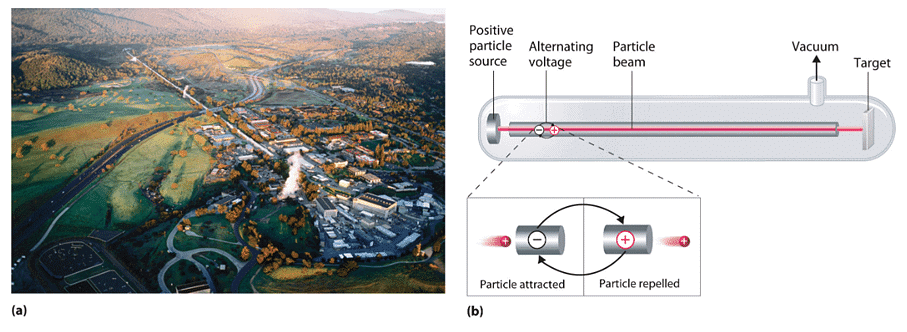 Figure 6: A Linear Particle Accelerator: (a) An aerial view of the SLAC, the longest linear particle accelerator in the world; the overall length of the tunnel is 2 miles.
Figure 6: A Linear Particle Accelerator: (a) An aerial view of the SLAC, the longest linear particle accelerator in the world; the overall length of the tunnel is 2 miles.
(b) Rapidly reversing the polarity of the electrodes in the tube causes the charged particles to be alternately attracted as they enter one section of the tube and repelled as they leave that section. As a result, the particles are continuously accelerated along the length of the tube.
In order to accomplish the desired result using less space, a cyclotron, a type of particle accelerator, is utilized. Instead of a straight path, the charged particles are compelled to move in a circular trajectory. The process involves injecting the particles into the center of a ring and employing two sizable D-shaped electrodes positioned above and below the ring. By rapidly changing the polarity of these electrodes, the particles are propelled outward along a spiral pathway towards the intended target.
The kinetic energy of particles in linear accelerators and cyclotrons is significantly restricted due to the length of the accelerator and the size of the D-shaped electrodes. However, these limitations can be surpassed by employing a synchrotron, which combines features of both designs. A synchrotron consists of a circular evacuated tube, resembling a linear accelerator but with a diameter that can exceed one mile. Within this tube, charged particles are accelerated by a sequence of magnets that rapidly alternate their polarities, enabling the particles to circulate around the circular path.
Summary and Key Takeaway
Nuclear decay reactions occur spontaneously under all conditions and produce more stable daughter nuclei, whereas nuclear transmutation reactions are induced and form a product nucleus that is more massive than the starting material.
In nuclear decay reactions (or radioactive decay), the parent nucleus is converted to a more stable daughter nucleus. Nuclei with too many neutrons decay by converting a neutron to a proton, whereas nuclei with too few neutrons decay by converting a proton to a neutron. Very heavy nuclei (with A ≥ 200 and Z > 83) are unstable and tend to decay by emitting an α particle. When an unstable nuclide undergoes radioactive decay, the total number of nucleons is conserved, as is the total positive charge. Six different kinds of nuclear decay reactions are known.
Alpha decay results in the emission of an α particle,  and produces a daughter nucleus with a mass number that is lower by 4 and an atomic number that is lower by 2 than the parent nucleus. Beta decay converts a neutron to a proton and emits a high-energy electron, producing a daughter nucleus with the same mass number as the parent and an atomic number that is higher by 1. Positron emission is the opposite of beta decay and converts a proton to a neutron plus a positron. Positron emission does not change the mass number of the nucleus, but the atomic number of the daughter nucleus is lower by 1 than the parent. In electron capture (EC), an electron in an inner shell reacts with a proton to produce a neutron, with emission of an x-ray. The mass number does not change, but the atomic number of the daughter is lower by 1 than the parent.
and produces a daughter nucleus with a mass number that is lower by 4 and an atomic number that is lower by 2 than the parent nucleus. Beta decay converts a neutron to a proton and emits a high-energy electron, producing a daughter nucleus with the same mass number as the parent and an atomic number that is higher by 1. Positron emission is the opposite of beta decay and converts a proton to a neutron plus a positron. Positron emission does not change the mass number of the nucleus, but the atomic number of the daughter nucleus is lower by 1 than the parent. In electron capture (EC), an electron in an inner shell reacts with a proton to produce a neutron, with emission of an x-ray. The mass number does not change, but the atomic number of the daughter is lower by 1 than the parent.
In gamma emission, a daughter nucleus in a nuclear excited state undergoes a transition to a lower-energy state by emitting a γ ray. Very heavy nuclei with high neutron-to-proton ratios can undergo spontaneous fission, in which the nucleus breaks into two pieces that can have different atomic numbers and atomic masses with the release of neutrons.
Many very heavy nuclei decay via a radioactive decay series—a succession of some combination of alpha- and beta-decay reactions. In nuclear transmutation reactions, a target nucleus is bombarded with energetic subatomic particles to give a product nucleus that is more massive than the original. All transuranium elements—elements with Z > 92—are artificial and must be prepared by nuclear transmutation reactions. These reactions are carried out in particle accelerators such as linear accelerators, cyclotrons, and synchrotrons.
Key Equations
1. alpha decay 2. beta decay
2. beta decay 3. positron emission
3. positron emission
4. electron capture 5. gamma emission
5. gamma emission
|
110 videos|130 docs|117 tests
|






















